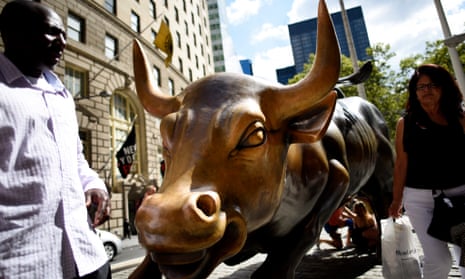After a tumultuous week on the world’s stock markets, investors will be focused on Wall Street Monday ahead of another set of economic reports likely to steer the Federal Reserve’s decision on whether to raise interest rates for the first time in almost a decade.
The markets open Monday as investors digest news that the Fed is still actively considering a September rate hike. In a speech on Saturday, Stanley Fischer, the vice-chair of the Fed’s Board of Governors, suggested inflationary pressures could soon lead to an increase.
His comments are likely to add to the volatility of already skittish markets. Hundreds of billions of dollars were wiped out and, mostly, gained back on stock markets across the world last week as traders and investors panicked about a possible slowdown in the Chinese economy, the world’s second-largest.
In New York, the Dow Jones industrial average index lost 1,000 points last Monday – a day dubbed Black Monday by Xinhua, China’s official news agency.
On Friday, the Dow closed down marginally for the day but up 1.1% for the week after rallying for two days on comments from Bill Dudley, the president of the New York Federal Reserve and the second-most important US central banker after Janet Yellen. In an interview, Dudley said it was unlikely that interest rates will rise in September, as had been widely expected for some months.
The indication that a rate rise would be delayed helped to calm investors unnerved by the prospect of an imminent tightening in credit costs in the world’s largest economy. The prospect of a rate increase by the Fed has also alarmed global stock markets, because it could draw investment funds out of emerging markets and back to the US.
Global central bankers this weekend debated what effect the past few days of global tumult on the stock markets should have on the Fed’s decision on 16-17 September about whether to raise interest rates, which have been held at near zero since the 2008 financial crisis.
The annual retreat to Jackson Hole, Wyoming, which has in previous years been dominated by discussion about the oncoming collapse of Lehman Brothers in 2008 and the Greek debt crisis, this year focused on what impact a Chinese slowdown could have on the US economy.
Fischer, the most senior speaker at Jackson Hole in the absence of Fed chair Janet Yellen, left the door open Saturday for a Fed rate increase in September.
Fischer said the factors that have kept inflation below the central bank’s target level have likely begun to fade.
He said there is “good reason to believe that inflation will move higher as the forces holding down inflation dissipate further”. He noted, for example, that some effects of a stronger dollar and a plunge in oil prices – key factors in holding down inflation – have already started to diminish.
Before the meeting, Fischer had said it was too early to say whether the market turmoil had had an effect on the decision. “I think it’s early to tell: the change in the circumstances which began with the Chinese devaluation is relatively new and we’re still watching how it unfolds, so I wouldn’t want to go ahead and decide right now what the case is – more compelling, less compelling, et cetera,” he told CNBC.
The August jobs report to be released on Friday will be key to the Fed’s rates decision. The policymakers have said reaching near effective full employment is essential before rates can be raised.
Last month, non-farm payrolls increased by 215,000 as a pickup in construction and manufacturing jobs offset further declines in the mining sector, and figures for previous months’ reports were revised up. The unemployment rate held steady at a seven-year low of 5.3%.
Better-than-expected gross domestic product (GDP) figures last week also helped boost sentiment. The Commerce Department said GDP increased by a 3.7% seasonally adjusted annual rate in the second quarter of 2015, up from the initial estimate of 2.3% growth. Economists had forecast a 3.3% rate.

Comments (…)
Sign in or create your Guardian account to join the discussion